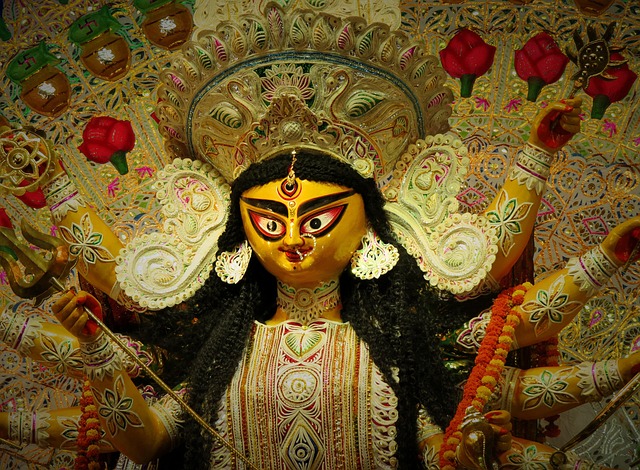Maha Ashtami, the eighth day of the Durga Puja festival, holds the most powerful spiritual and devotional resonance. It is the climax of the battle of righteousness, where the energy of the Divine Feminine, Shakti, is at its peak. This day is a profound call to honor your inner strength and seek the ultimate victory of good over evil in all aspects of life.
The Spiritual & Devotional Core
On Maha Ashtami, devotees invoke and worship Goddess Mahagauri (the eighth form of Durga) in some traditions, while in others, they honor all Eight Forms of Durga (Ashta Shakti), who emerged from the main deity to assist in the war against the demon Mahishasura.
- Commemorating Victory: This day primarily celebrates the triumphant manifestation of Goddess Durga’s sheer power, symbolizing the eradication of all negativity, internal and external.
- Awakening Inner Shakti: Maha Ashtami is a spiritual moment to awaken and connect with the divine feminine energy (Shakti) within oneself—fostering courage, conviction, and a renewed resolve to face life’s challenges.
- Community of Faith: The elaborate rituals transform the community space into a vibrant vortex of divine energy, where collective prayers deepen the spiritual bond between devotees and the Goddess.
Maha Ashtami Puja Rituals and Traditions
Maha Ashtami is defined by a series of powerful rituals, each laden with deep symbolic meaning:
1. Invocation of the Goddess (Bodhan)
The day begins with sacred chants and offerings to formally invoke the presence of the Goddess in the idol, marking the peak of the worship.
2. Astra Puja (Worship of Weapons)
Devotees ceremonially worship the weapons of Goddess Durga, recognizing them as manifestations of divine power and protection. In many households and workplaces, this extends to Ayudha Puja (worship of tools, machinery, and books), honoring the belief that one’s livelihood and knowledge are blessed by the Goddess.
3. Kumari/Kanya Puja (Worship of Young Girls)
This tender and vital ritual involves worshipping young, pre-pubescent girls (typically aged 2 to 10) as living embodiments of the Goddess. Their feet are washed, and they are offered special vegetarian foods (like halwa, puri, and payesh) and gifts. This ritual profoundly underscores the reverence for the divine feminine (Shakti) in its purest human form.
4. The Supreme Moment: Sandhi Puja
The most crucial ritual, the Sandhi Puja, takes place at the auspicious juncture where Maha Ashtami transitions into Maha Navami.
- Timing: This powerful period lasts for 96 minutes—the last 24 minutes of Ashtami and the first 24 minutes of Navami.
- Significance: It commemorates the exact moment when the Goddess Durga transformed into the Goddess Chamunda to defeat the formidable demons Chanda and Munda.
- Ritual: During this intense period, offerings are traditionally made, including 108 lotus flowers and 108 earthen lamps, symbolizing complete and fervent devotion.
5. Sacred Chants and Offerings
Devotees offer Pushpanjali (flower offerings) and perform grand Aarti. Devotees offer red flowers, fruits, coconut, sweets, and incense, accompanied by continuous chanting of hymns and mantras, reinforcing devotion and spiritual focus.
Maha Ashtami Puja Mantras
The following mantra, drawn from the Devi Mahatmya, is central to the worship on this day and is chanted during Pushpanjali to invite the Goddess’s blessings:
Ya Devi Sarvabhuteshu Shakti Rupena Samsthita
Namastasyai Namastasyai Namastasyai Namo Namah
Meaning: O Goddess, who resides in all beings in the form of Power,
Salutations to you, Salutations to you, Salutations to you.
Durga Saptashati Recitations – 700 verses recounting her divine victories and blessings.
Stotra and Suktam Chanting – Reciting Durga Stotra, Devi Kavach, and other hymns enhances spiritual protection and inner strength.
What to Follow (Dos)
- Maintain the cleanliness of the home and puja area, symbolizing purity for divine presence.
- Participate wholeheartedly in rituals, reciting mantras with devotion and sincerity.
- Treat young girls in Kumari Puja with care and respect, offering vegetarian delicacies.
- Perform acts of charity, humility, and compassion; community service amplifies spiritual merit.
What to Avoid (Don’ts)
- Refrain from non-vegetarian food, alcohol, and intoxicants.
- Avoid anger, quarrels, or distraction during puja. Focused devotion enhances spiritual benefit.
- Do not neglect offerings or perform rituals without proper intent, as faith and sincerity are essential.
- Avoid slovenliness or disrespect toward elders and community members.
Maha Ashtami Puja is a celebration of inner and outer victory, where spiritual intent must be paired with disciplined ritual and heartfelt devotion to truly honor the Goddess and absorb her protective and empowering blessings.
Feature Image Credit: Image by Sujay Ghosh from Pixabay. (free for commercial use)
